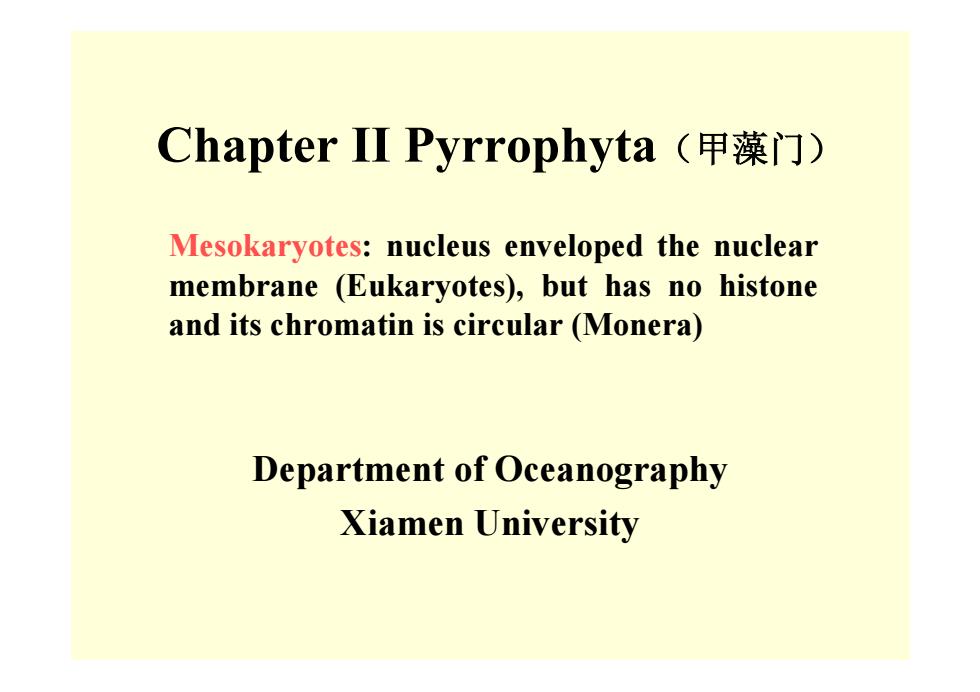
Chapter II Pyrrophyta(甲藻门) Department of Oceanography Xiamen University Mesokaryotes: nucleus enveloped the nuclear membrane (Eukaryotes), but has no histone and its chromatin is circular (Monera)
Chapter II Pyrrophyta(甲藻门) Department of Oceanography Xiamen University Mesokaryotes: nucleus enveloped the nuclear membrane (Eukaryotes), but has no histone and its chromatin is circular (Monera)
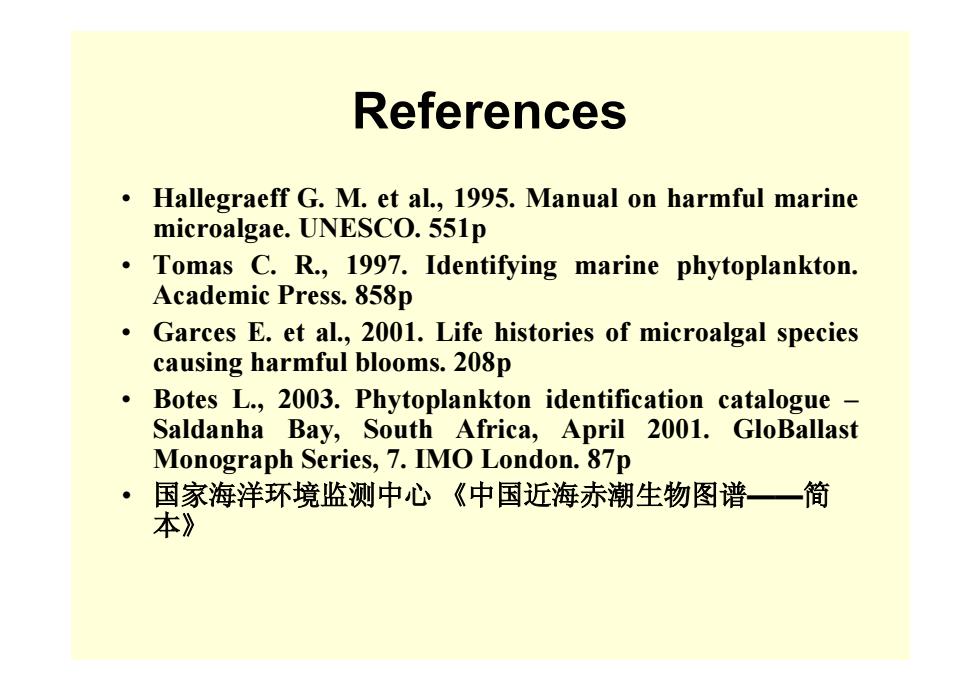
References • Hallegraeff G. M. et al., 1995. Manual on harmful marine microalgae. UNESCO. 551p • Tomas C. R., 1997. Identifying marine phytoplankton. Academic Press. 858p • Garces E. et al., 2001. Life histories of microalgal species causing harmful blooms. 208p • Botes L., 2003. Phytoplankton identification catalogue – Saldanha Bay, South Africa, April 2001. GloBallast Monograph Series, 7. IMO London. 87p • 国家海洋环境监测中心 《中国近海赤潮生物图谱——简 本》
References • Hallegraeff G. M. et al., 1995. Manual on harmful marine microalgae. UNESCO. 551p • Tomas C. R., 1997. Identifying marine phytoplankton. Academic Press. 858p • Garces E. et al., 2001. Life histories of microalgal species causing harmful blooms. 208p • Botes L., 2003. Phytoplankton identification catalogue – Saldanha Bay, South Africa, April 2001. GloBallast Monograph Series, 7. IMO London. 87p • 国家海洋环境监测中心 《中国近海赤潮生物图谱——简 本》
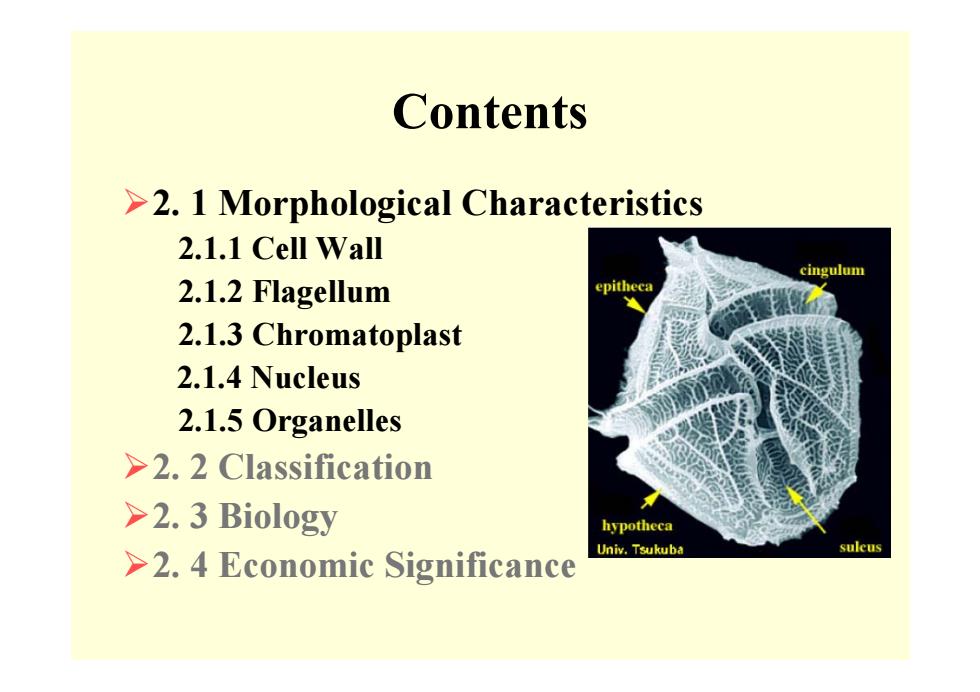
Contents ¾2. 1 Morphological Characteristics 2.1.1 Cell Wall 2.1.2 Flagellum 2.1.3 Chromatoplast 2.1.4 Nucleus 2.1.5 Organelles ¾2. 2 Classification ¾2. 3 Biology ¾2. 4 Economic Significance
Contents ¾2. 1 Morphological Characteristics 2.1.1 Cell Wall 2.1.2 Flagellum 2.1.3 Chromatoplast 2.1.4 Nucleus 2.1.5 Organelles ¾2. 2 Classification ¾2. 3 Biology ¾2. 4 Economic Significance

2.1.1 Cell Wall ¾ epicone apical pore plate apical plate precingular plate anterior intercalary plate ¾ hypocone antapical plate postcingular plate ¾ girdle plate ¾ ventral area left and right anterior plate left and right flagellar pore plate The cells are coated with a quite strong layer of amphiesma secreted by protoplasm; the cell wall of some naked species without theca are covered by thin plates
2.1.1 Cell Wall ¾ epicone apical pore plate apical plate precingular plate anterior intercalary plate ¾ hypocone antapical plate postcingular plate ¾ girdle plate ¾ ventral area left and right anterior plate left and right flagellar pore plate The cells are coated with a quite strong layer of amphiesma secreted by protoplasm; the cell wall of some naked species without theca are covered by thin plates
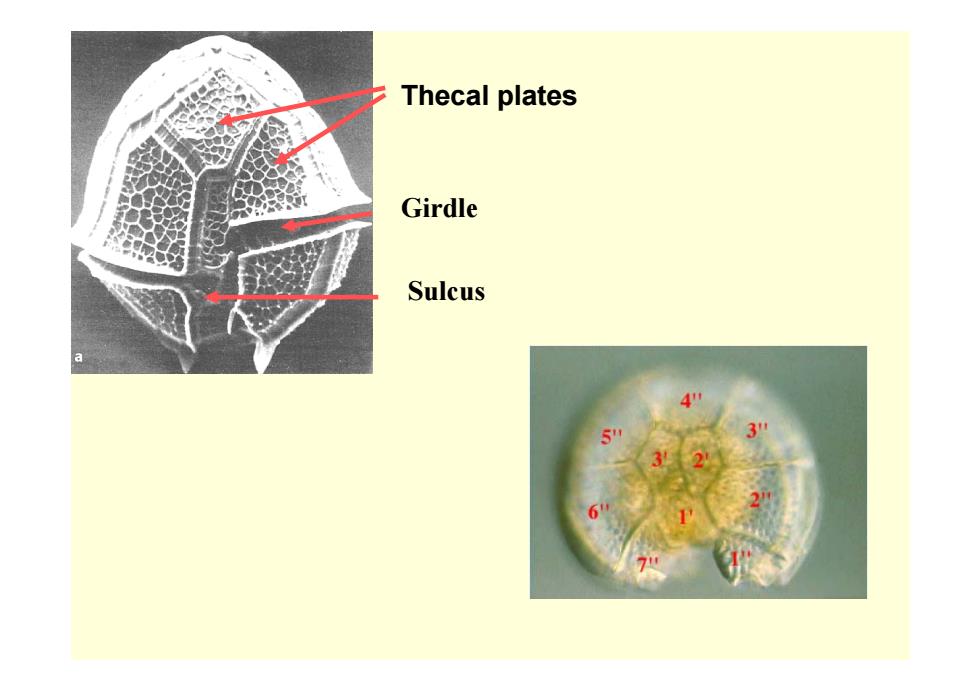
Thecal plates Girdle Sulcus
Thecal plates Girdle Sulcus
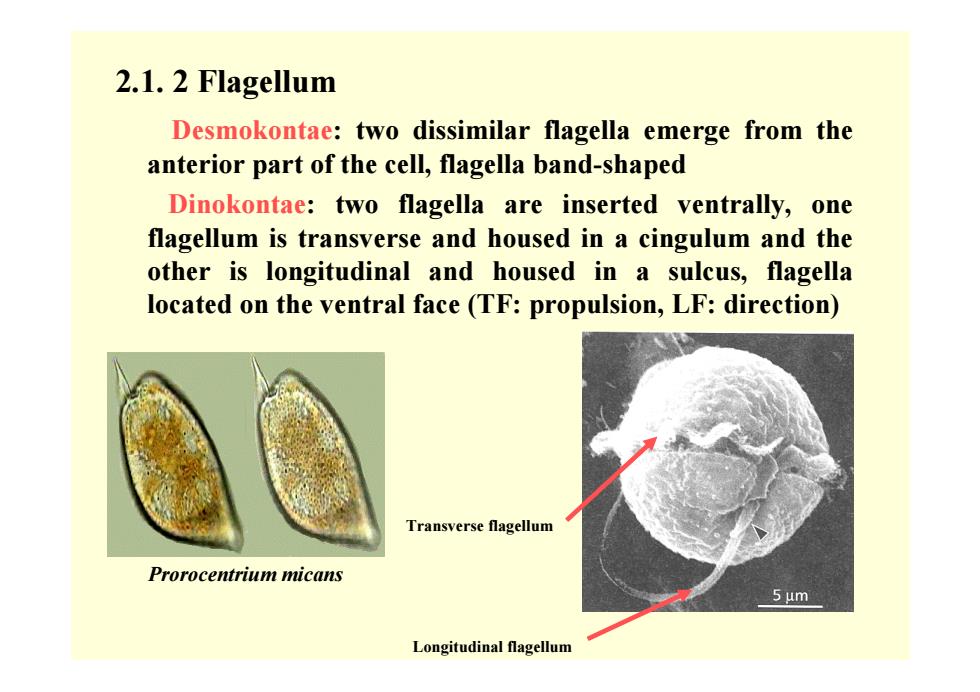
2.1. 2 Flagellum Desmokontae: two dissimilar flagella emerge from the anterior part of the cell, flagella band-shaped Dinokontae: two flagella are inserted ventrally, one flagellum is transverse and housed in a cingulum and the other is longitudinal and housed in a sulcus, flagella located on the ventral face (TF: propulsion, LF: direction) Prorocentrium micans Longitudinal flagellum Transverse flagellum
2.1. 2 Flagellum Desmokontae: two dissimilar flagella emerge from the anterior part of the cell, flagella band-shaped Dinokontae: two flagella are inserted ventrally, one flagellum is transverse and housed in a cingulum and the other is longitudinal and housed in a sulcus, flagella located on the ventral face (TF: propulsion, LF: direction) Prorocentrium micans Longitudinal flagellum Transverse flagellum
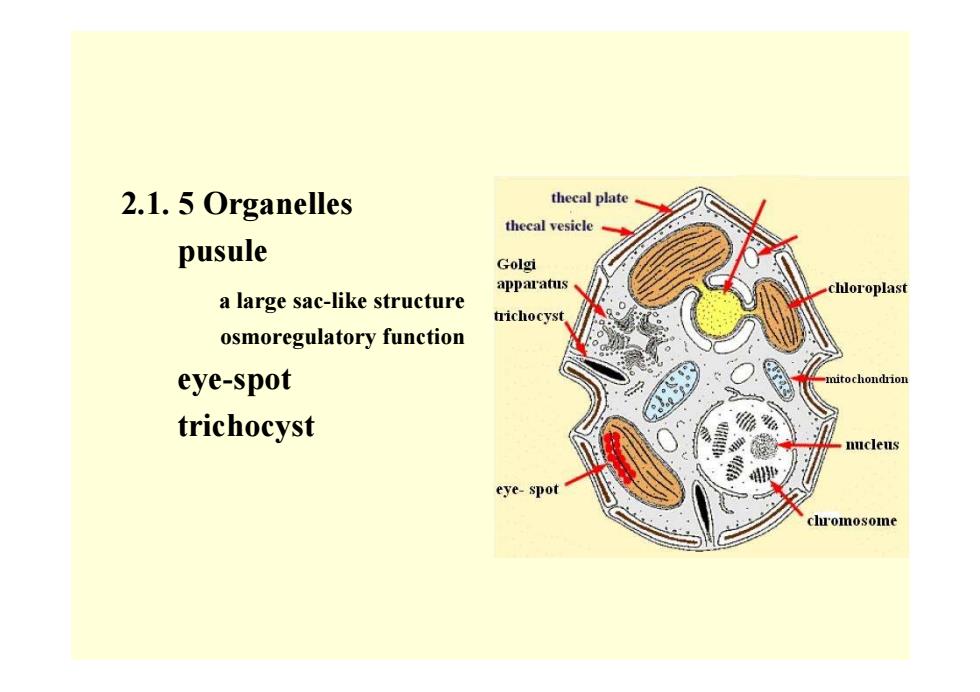
2.1. 5 Organelles pusule a large sac-like structure osmoregulatory function eye-spot trichocyst
2.1. 5 Organelles pusule a large sac-like structure osmoregulatory function eye-spot trichocyst
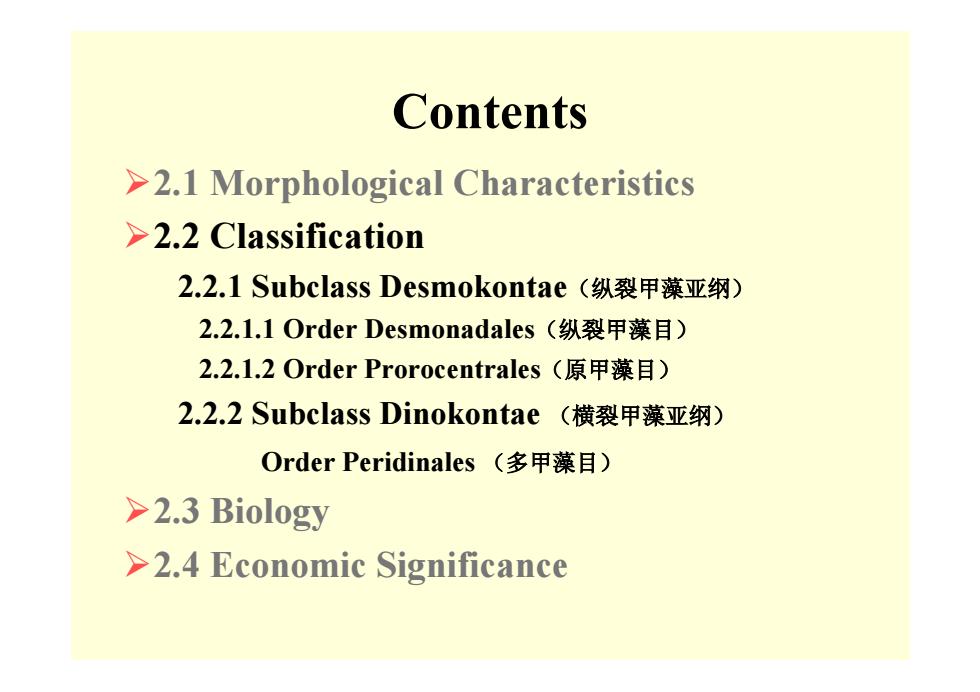
Contents ¾2.1 Morphological Characteristics ¾2.2 Classification 2.2.1 Subclass Desmokontae(纵裂甲藻亚纲) 2.2.1.1 Order Desmonadales(纵裂甲藻目) 2.2.1.2 Order Prorocentrales(原甲藻目) 2.2.2 Subclass Dinokontae (横裂甲藻亚纲) Order Peridinales (多甲藻目) ¾2.3 Biology ¾2.4 Economic Significance
Contents ¾2.1 Morphological Characteristics ¾2.2 Classification 2.2.1 Subclass Desmokontae(纵裂甲藻亚纲) 2.2.1.1 Order Desmonadales(纵裂甲藻目) 2.2.1.2 Order Prorocentrales(原甲藻目) 2.2.2 Subclass Dinokontae (横裂甲藻亚纲) Order Peridinales (多甲藻目) ¾2.3 Biology ¾2.4 Economic Significance

one class, Dinophyceae Based on living habits and the location of flagellum, the class is divided into 3 subclasses 2.2.1 Subclass Desmokontae(纵裂甲藻亚纲) 2.2.1.1 Order Desmonadales(纵裂甲藻目) 2.2.1.2 Order Prorocentrales(原甲藻目) 2.2.2 Subclass Dinokontae (横裂甲藻亚纲) Order Peridinales (多甲藻目) 2.2.2.1 Suborder Gymnodiniineae(裸甲藻亚目) 2.2.2.2 Suborder Dinophysidineae(翅甲藻亚目) 2.2.2.3 Suborder Peridiniineae(多甲藻亚目) 2.2.3 Subclass Blastodinophycidae(囊甲藻亚纲)
one class, Dinophyceae Based on living habits and the location of flagellum, the class is divided into 3 subclasses 2.2.1 Subclass Desmokontae(纵裂甲藻亚纲) 2.2.1.1 Order Desmonadales(纵裂甲藻目) 2.2.1.2 Order Prorocentrales(原甲藻目) 2.2.2 Subclass Dinokontae (横裂甲藻亚纲) Order Peridinales (多甲藻目) 2.2.2.1 Suborder Gymnodiniineae(裸甲藻亚目) 2.2.2.2 Suborder Dinophysidineae(翅甲藻亚目) 2.2.2.3 Suborder Peridiniineae(多甲藻亚目) 2.2.3 Subclass Blastodinophycidae(囊甲藻亚纲)
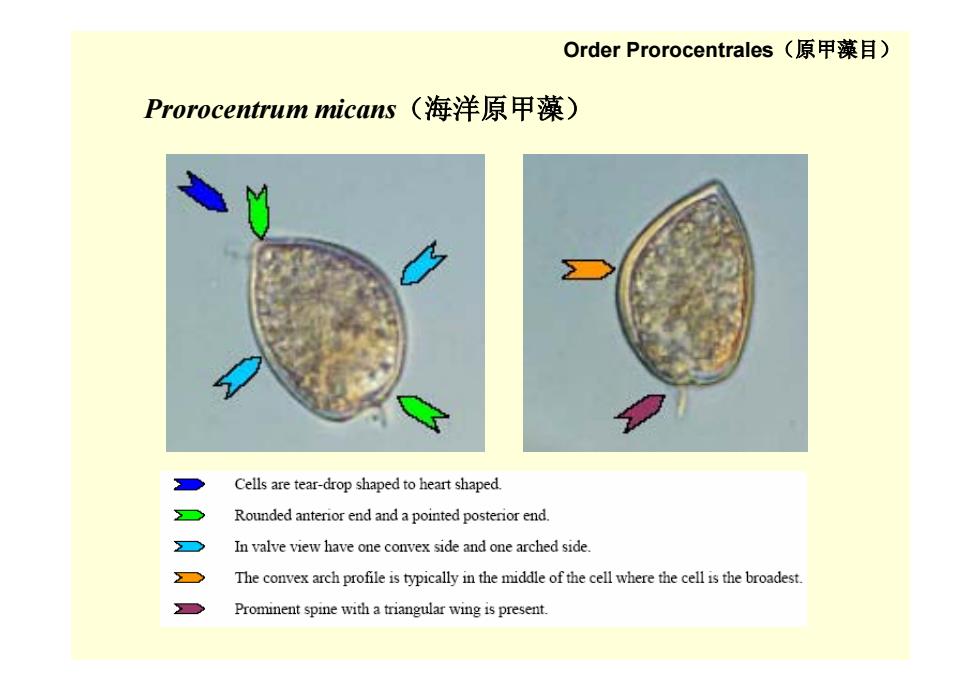
Prorocentrum micans(海洋原甲藻) Order Prorocentrales(原甲藻目)
Prorocentrum micans(海洋原甲藻) Order Prorocentrales(原甲藻目)